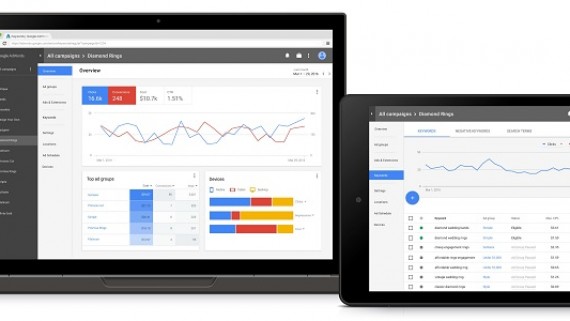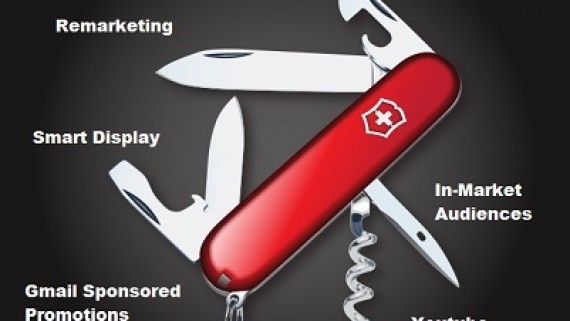What Is Quality Score and Why Is It So Important?
Quality Score (QS) measures how relevant your Ads, landing page, and other aspects of your campaign are for a given keyword.
Quality score for any given keyword is important because, along with your Max. CPC, it directly affects your Ad Rank.
A high Quality Score translates into cheaper clicks, and higher Ad Positions, and thus directly affects the amount of profit your campaign generates overtime.
The advertiser with the highest Quality Score will be required to pay less than the rest in order to appear in the 1st place position, while having a low Quality Score can mean that your Ad is not eligible to show for that keyword at all.
Be aware:
The Quality Score that you see in Adwords for each keyword is a rough guide only, that indicates how relevant your overall campaign is, as compared to your competitors. This simple 1 – 10 figure cannot indicate to you what your real-time Quality Score will be in any given auction.
Here are some factors which affect our auction QS, but which are not reflected in your 1-10 score:
- Geographic location of searcher
- Time during the day
- Device used by the searcher
- Quality of your site-link extensions
- The quality of multiple Ads within your Ad Group
- Negative keywords being used
Google says:
“chasing the number” shouldn’t be the focus of your optimizations. Be relevant, be compelling and drive traffic to landing pages that deliver on what you promise in your ad, and you can feel confident your score should reflect that quality.
Why it works this way?
Google are interested in keeping web users happy by providing them with the content which most closely matches their search query. Thus they give a higher Ad Rank to advertisers with a high Quality Score.
At the same time Google wants to maximise their revenue from advertisers, by allowing them to compete in an auction where the highest bid combines with the highest QS to define each advertisers ultimate Ad Rank.
How to check your Quality score for a keyword– and see which factors you are doing well in:
- Hover over the speech bubble for the keyword in question
These three factors: Expected click-through rate, Ad relevance, and Landing page experience are the main components of your Quality Score for a given keyword, and are the main place to look for an indication of where improvements can be made.
In the example screenshot above, it is indicated that improvements should be made first in the CTR and Ad relevance. Although the Landing page experience has an Above average grade, this doesn’t mean to say there aren’t improvements that can still be made to improve the user experience.
How to Improve Your Quality Score
Keyword Quality Score is defined by several features which are compared to the other advertisers who are bidding on the same keyword – it’s a competition.
Below is a description of how the three main components are graded, and how to improve their quality:
- Expected Click-Through-Rate (contributes 60%)
This is the frequency with which users click on your Ads for that keyword. This is the most important factor, because Google want the most prominent Ads on the page to be the Ads which generate the most clicks, and the highest profits for them.
Create compelling and engaging Ad Text
- Attained by having enticing, eye-catching, and engaging Ad Text –
- Offer deals, highlight benefits, and use a call-to-action, e.g. Free Shipping Today Only! Or Buy Now for 30% Off!
- Capitalise the first letter of each word
- Use an exclamation mark in the body once (never in the title)
Expected, not actual
Also remember that your Ads are judged on their Expected CTR, not their actual average CTR. Your Ads may have a very high CTR, but past performance is only one factor that is taken into account when calculating what your CTR is Expected to be. Having Ad Extensions, and Ad Text which is deemed to be compelling, are other factors which will influence your Expected CTR.
Balance CTR with Conversion Rate
There will be times when a one specific Ad Text will get a lower CTR, but a higher Conversion Rate than another Ad Text. Therefore if maximising our bottom-line is our objective, we should take into account the conversion rate of an Ad as much as its CTR.
Using the Keyword In Ad Text
Keyword appears in:
- Ad Text Title
- Ad Text Body
- Destination URL if possible
- Display URL
Users will be attracted by the sight of the keyword they have searched for, and the keyword will appear in bold multiple times in your Ad Text.
Let’s look at this Ad for the keyword: “web design”
Notice how the keyword/ close variant of the keyword appears, and is highlighted, three times in the Ad Text. This helps to attract the attention of the user, improving the CTR, and can also have a positive impact on the relevance, thus improving the QS in two ways.
Site-link extensions, Call extensions, Review Extensions etc.
Each of these extensions gives users an additional way to interact with your Ads, and will often increase the chance of users being attracted to and clicking on your Ad.
Because of this – Google can give you a higher Expected Click-Through-Rate because it is estimated that having extensions will generate your Ad more clicks.
Once your Ad begins accumulating additional clicks, this in turn will also contribute toward your higher CTR.
Catering for User’s Device
Catering your Ad Text for mobile phones could help to improve your Expected CTR. For example if users are intending to speak to someone on the phone, then using Mobile targeted Ads which implement Call-Extensions, allowing mobile users to call you directly without have to click through to your landing page may well give you an edge over your competitors.
When Targeting New Keywords
When you are targeting new keywords that have not accumulated any history, Adwords will look at your past performance on similar keywords in order to base your Quality Score on.
Be Careful of What You Claim In Your Ad Text to Get A High CTR
Keep in mind though that anything you promise within the Ad Text should follow on the landing page. If you promise a specific type of deal or product in your Ad and it does not appear on your page, this could potentially affect your QS. Google has manual reviewers who may look over your website, and if it does not appear to provide a genuine service or content, this could well work against you.
Higher Positions and CTR
Although being in a higher position will improve the number of clicks we generate, our Avg CTR takes into account, and is normalised based on our Avg Position, and thus bidding higher amounts in order to appear higher in the rankings will not gain us a higher QS. The Max. CPC we choose should therefore be based on our profitability for that keyword.
- Ad Relevance (contributes 30%)
How relevant is the keyword to your Ad Text, Ad Group, and Landing Page.
- How relevant is your Ad Text to the keyword?
Does the rest of the Ad Text Body relate well semantically to the keyword? The relevance that your Ad has to a specific keyword or search term is ultimately subjective. However, if your Ad relevance appears to be a cause for concern, consider the following:
Is the keyword contained in the:
- Ad Text Title
- Ad Text Body
- Destination URL if possible
- Display URL
How Precisely Targeted and Defined Are Your Ad Groups?
If we have an Ad Group with the following keywords:
- [Web Designers]
- Web Design
- “Cheap Web Design”
- [Web Developers]
And we have the following Ad Text that caters for these keywords:
We may see that we have a good QS for [Web Designers], and Web Design, but that our QS for “Cheap Web Design” and [Web Developers] is lacking. This could be because the Ad Text does not contain these keywords, and thus to resolve this issue, we should create a new Ad Group specifically for these keywords, and create Ad Text catered for them.
The opposite problem can occur where we have a small number of highly related keywords in an Ad Group, e.g. “web design surrey”, “surrey web design” and “surrey website designers”, but we have many different Ad Text.
Although one Ad Text is highly relevant, we are running several other Ad Text which are not so relevant, and this brings down our overall relevancy score.
Using dynamic Ad Text
When targeting a broad match keyword, modified broad match, or even a phrase match keyword, there can be many possible search terms that your Ad may appear for. In order enable your Ad to cater itself, and make itself specific to each search term, you can implement dynamic Ad Text, whereby the users search query automatically appears within your Ad, making it more relevant to the search term.
Using Negative Keywords
Using negative keywords is an effective way of prevent your Ads from appearing for keywords which your Ad might activate by which are not necessary related to your Ad, and which are not beneficial to your marketing campaign.
- Landing Page
Don’t use generic landing pages, make a landing page specific to each keyword with the keyword inserted into the title of the landing page.
- Landing Page Experience (contributes 10%)
How relevant your page is, its speed, usability, and transparency
- Make sure your page loads fast – web users don’t like to wait for pages to load, so a few mili seconds is all it should take. This can be achieved by optimising images, creating an HTML page, optimising any Java Script.
- Original content – your website does not copy others. Try to add more value than you competitors in some way.
- Transparent services – Your site is not misleading; you don’t hide links; you don’t try to pose as a website you are not, and don’t pretend to provide a service that you do not. You’re a responsible webmaster, and provide users with access to useful pages like Terms of Service, Contact Us page, Privacy Policy, FAQ, and About Us page.
- Navigability – The website is easy to navigate, the links are clear and easy to find, and there’s a Sitemap. The user can quickly see what they need to do in order to purchase an item, or carry out actions. Calls-to-action are clearly defined.
Check Your Site Engagement
Using tools such as Google Analytics can help us understand how web users are engaging with our website. By looking on things such as bounce rate, time on page, heat maps, goals, and conversions, we can see how well users are interacting with our website, and see where improvements need to be made.
Remember to preserve the scent of the search:
The user types in “Cheap Dog food”, the user then sees your Ad with the title “Cheap Dog food – 50% Off”, then once they click through, the landing page title reads “Cheap Dog Food Deals – Get up-to 50% off!”
At every stage, their initial search “cheap dog food” is mentioned – this not only attracts the user’s attention to our Ad Text, but once on your landing page it makes the user feel comfortable that they have landed on the correct page.
These practices won’t just improve your quality score, but they also have the added effect of boosting your conversion rate!
Other Devices:
Our website may look great on a desktop computer, but how does it look on mobile phones and tablets? It’s crucial to make sure that user experience is good on all devices, and this may mean having to create a separate landing page for mobile phones, to make sure that all of the site’s content is proportioned correctly for a smaller screen, or creating a website that is responsive so that it adapts its layout and structure according to the user’s screen size.
This is especially important as more and more users are turning to their mobile phone and tablets in order to surf the web.
What About Account Quality Score?
Although Google don’t directly refer to an overall Account Quality Score, it is widely believed that the average quality score of your keywords can influence the quality score Google attributes to new keywords within your account. For this reason it is beneficial to minimise the number of keywords with low quality scores within your account, even if you are generating revenue from these keywords, as they can bring down your Account Quality Score.










Comments
No comment yet.